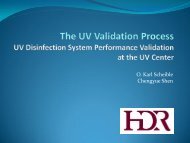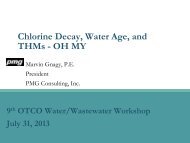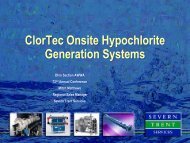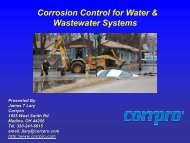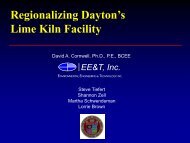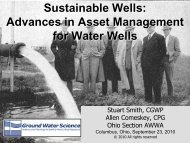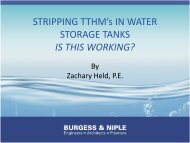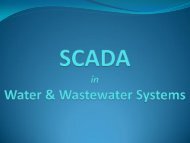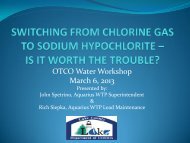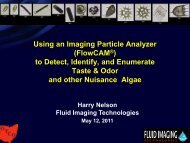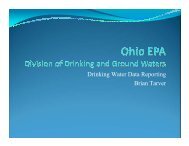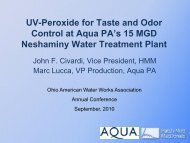Stage-2-Disinfection By-Products Rule - Ohiowater.org
Stage-2-Disinfection By-Products Rule - Ohiowater.org
Stage-2-Disinfection By-Products Rule - Ohiowater.org
You also want an ePaper? Increase the reach of your titles
YUMPU automatically turns print PDFs into web optimized ePapers that Google loves.
<strong>Stage</strong> 2 DBPR Purpose• Does <strong>Stage</strong> 2 apply to me?– Applies to all community water systems and nontransient noncommunitywater systems that produce and/or deliver water that is treated with aprimary or residual disinfectant other than UV• Strengthen existing regulations• Reduce potential health risks– Cancer (bladder, colon, rectal)– Reproductive health effects (miscarriage, stillbirth, sperm effects, birthdefects)– Developmental health effects (low birth weight, cardiac defects, growthretardation)• Tighten compliance monitoring requirements for TTHMs and HAA5s(Locational Running Annual Average – LRAA)• Address high concentrations in the distribution system
<strong>Stage</strong> 2 DBPR Requirements• Initial Distribution System Evaluation (IDSE)– Identify high risk locations in system– Identify <strong>Stage</strong> 2 DBPR monitoring sites• Compliance and Monitoring– Reduce exposure and lowering DBP peaks– New method for MCL compliance (LRAA)• Consecutive Systems– Are on the same schedule as the wholesale system– Must comply with the same schedule as the system serving the largest population inthe combined distribution system
Compliance & Monitoring• Two DBP classes of concern– TTHM & HAA5• New MCL compliance calculation– The MCLs remain the same….TTHM = 0.080 mg/LHHA5 = 0.060 mg/L….but the calculation will change– RAA and LRAA• <strong>Stage</strong> 1 requires the RAA at all monitoring locations• <strong>Stage</strong> 2 requires the LRAA at each monitoring location
RAA versus LRAA• <strong>Stage</strong> 1 – Running Annual Average– An average of all quarterly samples is calculated– (Samp1 + Samp2 + Samp3 + Samp4)/4 = Quarterly Average– (Q1 + Q2 + Q3 + Q4)/4 = RAA• <strong>Stage</strong> 2 – Locational Running Annual Average – forIDSE and Compliance Monitoring– An average of all quarterly samples is calculated– (Site1 Q1 + Site1 Q2 + Site1 Q3 + Site1 Q4)/4 = LRAA for Site 1– (Site2 Q1 + Site2 Q2 + Site2 Q3 + Site2 Q4)/4 = LRAA for Site 2– (Site3 Q1 + Site3 Q2 + Site3 Q3 + Site3 Q4)/4 = LRAA for Site 3– (Site4 Q1 + Site4 Q2 + Site4 Q3 + Site4 Q4)/4 = LRAA for Site 4
Schedule Determination• Determined by the population served by a PWS or by the largestpopulation served by a PWS in your Combined Distribution System.ScheduleServing (orconnected to asys serving):Submit40/30, SMP,or SSS <strong>By</strong>:CompleteStandardMonitoring orSSS <strong>By</strong>:Submit IDSEReport <strong>By</strong>:1> 100,00010/1/20069/30/20081/1/2009250,000–99,9994/1/20073/31/20097/1/2009310,000–49,99910/1/20079/30/20091/1/20104< 10,0004/1/20083/31/20107/1/2010
IDSE Basics• Identify high risk locations• Select high TTHM & HAA5 sites for <strong>Stage</strong> 2compliance• If elevated concentrations are not present, treatment changesare not required• Four Sampling Options Available• Monitoring frequency and location is based on sourcewater type (either Subpart H or Ground Water)• Is a one time study• Data must be included in CCR
IDSE Options• Standard Monitoring Plan– Most Common Option– One year of data collection– Plan must be approved byprimacy agency– If you do not receive approval,assume you’re OK to begin• System Specific Study– Two types• Hydraulic Model• Existing Monitoring Data• Very Small System (VSS)Waiver– Serve < 500 people– Have taken THM & HAA samples– Contact your primacy agency• 40/30 Certification– System must have complied withall <strong>Stage</strong> 1 requirements– No TTHM may have exceeded 40ppb– No HAA5 may have exceeded 30ppb– No monitoring violations
<strong>Stage</strong> 2 Classifications• Columbus is a subpart H water system– 2 surface water plants• Hap Cremean Water Plant (HCWP)• Dublin Road Water Plant (DRWP)– 1 ground water plant• Parsons Avenue Water Plant (PAWP)• Columbus is a mega water system - we deal directly with USEPAin DC (but are often referred to Region 5)• Schedule 1 and 2 systems deal with Region 5• At present, unsure if Schedule 3 and 4 systems will deal withOEPA or Region 5
Pre-IDSE Site Selection Work• Conducted IDSE Site Selection Study at 93 sites– Sites were:• TCR sites• <strong>Stage</strong> 1 sites• Routine water quality monitoring sites– Paired TTHM/HAA5 samples from all 93• June 19 to July 5, 2006• Chlorine Analysis Study for 13 months at same 93sites• Population data from 2000 census• Top 20 users based on billing records
Created Four Working Maps• TTHM, HAA5, Chlorine Residual, andPopulation• All four contained– Sources– Plants– Mains 12” and larger– Tanks and booster pumping stations– 17 pressure districts– Zones of influence for each plant– 93 monitoring sites (including <strong>Stage</strong> 1)
Final IDSE Site Selection• Required to select 24 locations• Based on the percentage of daily pumping data– 49% HCWP – 12 sites– 37% DRWP – 9 sites (selected 10)– 14% PAWP – 3 sites (only selected 2)(Didn’t focus on PAWP because THM and HAA are very low)Near EPAverageHigh TTHMHigh HAA5Required4686Selected3696
Site Selection• Near Entry Points– 4 locations are required, but….we selected 3– Fourth was changed to a high THM site– Selected plant taps as monitoring site• Average– Used average chlorine residual as average water age– Population and top 20 users– Prior to storage tanks– Verified sites were average with TTHM and HAA5data– Also checked to make sure they were spatially andhydraulically diverse
Site Selection (con’t)• High TTHM & High HAA5– Both were >80% of the MCL– Low chlorine residual– Storage tank considerations– Close to the last customer and/or in lowflow/hydraulic dead-ends– Considered population density and proximityto large users and consecutive systems– Evaluated heterotrophic plate count (HPC)data (for HAA5)
Examples of HAA5 SiteJustification• IDSE 24 (Mound Pressure District)• This site was selected as a high HAA5 location• The site is located west of the geographic center of thecity just prior to two storage tanks near the end of apressure district, but not the end of the distributionsystem• The average chlorine residual (1.16 ppm) was slightlylower than the DRWP service area average• The range of residual chlorine fluctuates greatly from0.49 to 1.75 ppm• The HPC data for this site indicate little biological activity• The HAA5 summer 2006 value was >80% of the MCLand the TTHM value was also elevated
Peak Historical Month• Controlling month for sample collection– Our controlling month is September• Based on high TTHM or HAA5 levels ortemperature• Represent “worst case” conditions whenDBPs are highest
Initial IDSE Sampling• Performed in September, 2007• Next sampling is tomorrow• Parameters Measured– Temp (on-site) – Free & Total Chlorine (on-site)– TTHM– Conductivity– HAA5– pH– Turbidity
Lessons Learned• Found areas in the City with worse water qualitythan thought• Also, found areas with better WQ than thought• Discovered unexpected blends in thedistribution system• Things will change – before any sampling wasperformed we had to change two locations
• USEPA <strong>Stage</strong> 2 Homepagehttp://www.epa.gov/safewater/disinfection/stage2• IDSE Toolhttp://www.epa.gov/safewater/disinfection/tools/toolsidse.html• OEPA <strong>Stage</strong> 2 – LT2 List servehttp://www.epa.state.oh.us/ddagw/listserve_lt2.htm
?Questions?jskauffman@columbus.gov



